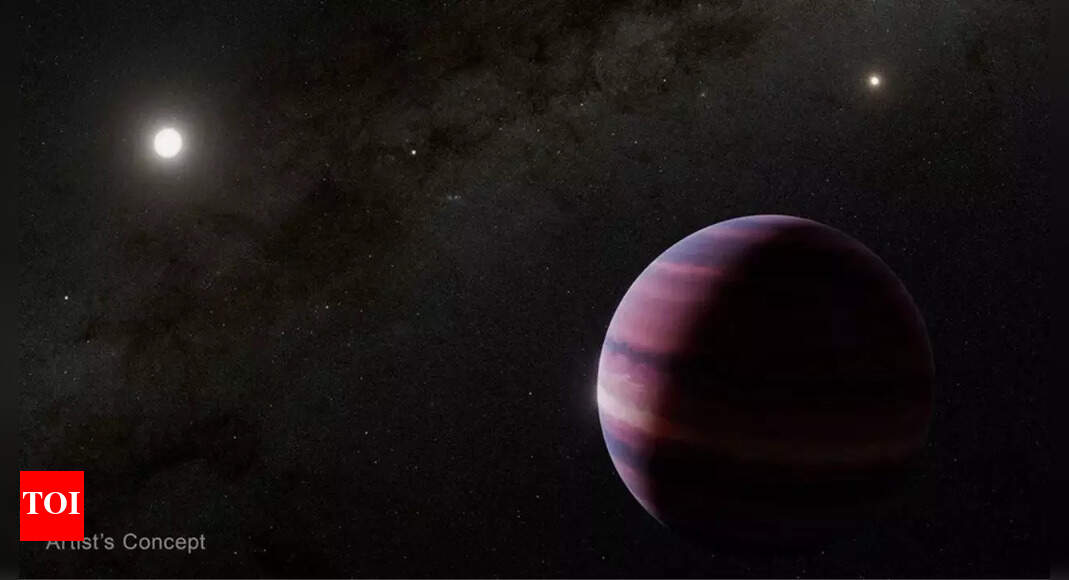James Webb telescope detects possible new exoplanet just 4 light-years away from Earth | – The Times of India

In a stunning breakthrough, astronomers using NASA’s James Webb Space Telescope (JWST) have found strong evidence of a new exoplanet orbiting Alpha Centauri A, the closest sun-like star to Earth, just 4.37 light-years away. Using its Mid-Infrared Instrument (MIRI) and a coronagraph to block stellar glare, JWST captured a faint object believed to be a gas giant within the star’s habitable zone. Though not suitable for life as we know it, the potential planet represents a major leap in exoplanetary science and could be the closest directly imaged world outside our solar system.
James Webb telescope captures glimpse into a nearby system
Alpha Centauri A is part of the Alpha Centauri triple-star system, which also includes Alpha Centauri B and the red dwarf Proxima Centauri. While Proxima has two confirmed planets, including the potentially habitable Proxima b, Alpha Centauri A has long been a target of interest due to its similarities to our own sun. The discovery of a candidate planet orbiting it is not only thrilling; it is historic.What makes this discovery even more compelling is the location of the possible exoplanet: within the habitable zone of Alpha Centauri A. At a distance of two astronomical units from its host star (twice the distance from Earth to the Sun), the gas giant lies in the region where liquid water could exist, at least on moons if it has any. However, as a gas giant, it is unlikely to support life directly.
Cutting-edge tech behind the discovery
The JWST used its Mid-Infrared Instrument (MIRI) along with a coronagraphic mask to suppress the overwhelming light from Alpha Centauri A, revealing the faint signature of the suspected planet. The object is about 10,000 times fainter than its host star, an extraordinary contrast achieved thanks to the telescope’s unprecedented sensitivity.If confirmed, this would be the closest exoplanet ever directly imaged around a sun-like star and the first such planet to be observed at this proximity. The discovery hints at the possibility that planetary systems similar to ours may be more common and closer than previously thought.
A new era for nearby exploration
Scientists are already excited about the opportunities this planet offers. As Charles Beichman of NASA’s Exoplanet Science Institute noted, the proximity of Alpha Centauri A makes it one of the best candidates for future in-depth studies. With new instruments and missions on the horizon, this system could become a focal point for the next generation of space exploration.While promising, the object is still considered a planet “candidate.” Further observation and analysis are needed to confirm its nature. If validated, it would mark a major milestone and open the door to studying exoplanets not just light-years away but potentially within reach of future interstellar probes.
From science to sci-fi
The discovery has also thrilled science fiction fans, especially since James Cameron’s Avatar series is set on Pandora, a lush, habitable moon orbiting a gas giant around Alpha Centauri A. This cinematic connection has long stirred public imagination about what might exist in our cosmic neighborhood.Now, with real scientific data pointing to a massive planet in that same system, the boundary between fiction and possibility feels thinner than ever. While this newfound world is unlikely to host life itself, its presence raises the possibility of moons or other celestial bodies in its orbit that could offer more Earth-like conditions.It also reinforces the cultural and scientific fascination with Alpha Centauri as humanity’s first potential step beyond the solar system — a destination for future probes or even interstellar travel concepts like Breakthrough Starshot.With the James Webb Space Telescope continuing to exceed expectations, discoveries like this are no longer confined to science fiction. They are part of a new, unfolding reality — one where humanity’s view of the cosmos expands with every image, every pixel, and every distant light revealed.
var _mfq = window._mfq || [];
_mfq.push([“setVariable”, “toi_titan”, window.location.href]);
!(function(f, b, e, v, n, t, s) {
function loadFBEvents(isFBCampaignActive) {
if (!isFBCampaignActive) {
return;
}
(function(f, b, e, v, n, t, s) {
if (f.fbq) return;
n = f.fbq = function() {
n.callMethod ? n.callMethod(…arguments) : n.queue.push(arguments);
};
if (!f._fbq) f._fbq = n;
n.push = n;
n.loaded = !0;
n.version = ‘2.0’;
n.queue = [];
t = b.createElement(e);
t.async = !0;
t.defer = !0;
t.src = v;
s = b.getElementsByTagName(e)[0];
s.parentNode.insertBefore(t, s);
})(f, b, e, ‘https://connect.facebook.net/en_US/fbevents.js’, n, t, s);
fbq(‘init’, ‘593671331875494’);
fbq(‘track’, ‘PageView’);
};
function loadGtagEvents(isGoogleCampaignActive) {
if (!isGoogleCampaignActive) {
return;
}
var id = document.getElementById(‘toi-plus-google-campaign’);
if (id) {
return;
}
(function(f, b, e, v, n, t, s) {
t = b.createElement(e);
t.async = !0;
t.defer = !0;
t.src = v;
t.id = ‘toi-plus-google-campaign’;
s = b.getElementsByTagName(e)[0];
s.parentNode.insertBefore(t, s);
})(f, b, e, ‘https://www.googletagmanager.com/gtag/js?id=AW-877820074’, n, t, s);
};
function loadSurvicateJs(allowedSurvicateSections = []){
const section = window.location.pathname.split(‘/’)[1]
const isHomePageAllowed = window.location.pathname === ‘/’ && allowedSurvicateSections.includes(‘homepage’)
const ifAllowedOnAllPages = allowedSurvicateSections && allowedSurvicateSections.includes(‘all’);
if(allowedSurvicateSections.includes(section) || isHomePageAllowed || ifAllowedOnAllPages){
(function(w) {
function setAttributes() {
var prime_user_status = window.isPrime ? ‘paid’ : ‘free’ ;
var geoLocation = window?.geoinfo?.CountryCode ? window?.geoinfo?.CountryCode : ‘IN’ ;
w._sva.setVisitorTraits({
toi_user_subscription_status : prime_user_status,
toi_user_geolocation : geoLocation
});
}
if (w._sva && w._sva.setVisitorTraits) {
setAttributes();
} else {
w.addEventListener(“SurvicateReady”, setAttributes);
}
var s = document.createElement(‘script’);
s.src=”https://survey.survicate.com/workspaces/0be6ae9845d14a7c8ff08a7a00bd9b21/web_surveys.js”;
s.async = true;
var e = document.getElementsByTagName(‘script’)[0];
e.parentNode.insertBefore(s, e);
})(window);
}
}
window.TimesApps = window.TimesApps || {};
var TimesApps = window.TimesApps;
TimesApps.toiPlusEvents = function(config) {
var isConfigAvailable = “toiplus_site_settings” in f && “isFBCampaignActive” in f.toiplus_site_settings && “isGoogleCampaignActive” in f.toiplus_site_settings;
var isPrimeUser = window.isPrime;
var isPrimeUserLayout = window.isPrimeUserLayout;
if (isConfigAvailable && !isPrimeUser) {
loadGtagEvents(f.toiplus_site_settings.isGoogleCampaignActive);
loadFBEvents(f.toiplus_site_settings.isFBCampaignActive);
loadSurvicateJs(f.toiplus_site_settings.allowedSurvicateSections);
} else {
var JarvisUrl=”https://jarvis.indiatimes.com/v1/feeds/toi_plus/site_settings/643526e21443833f0c454615?db_env=published”;
window.getFromClient(JarvisUrl, function(config){
if (config) {
const allowedSectionSuricate = (isPrimeUserLayout) ? config?.allowedSurvicatePrimeSections : config?.allowedSurvicateSections
loadGtagEvents(config?.isGoogleCampaignActive);
loadFBEvents(config?.isFBCampaignActive);
loadSurvicateJs(allowedSectionSuricate);
}
})
}
};
})(
window,
document,
‘script’,
);
[title_words_as_hashtags




